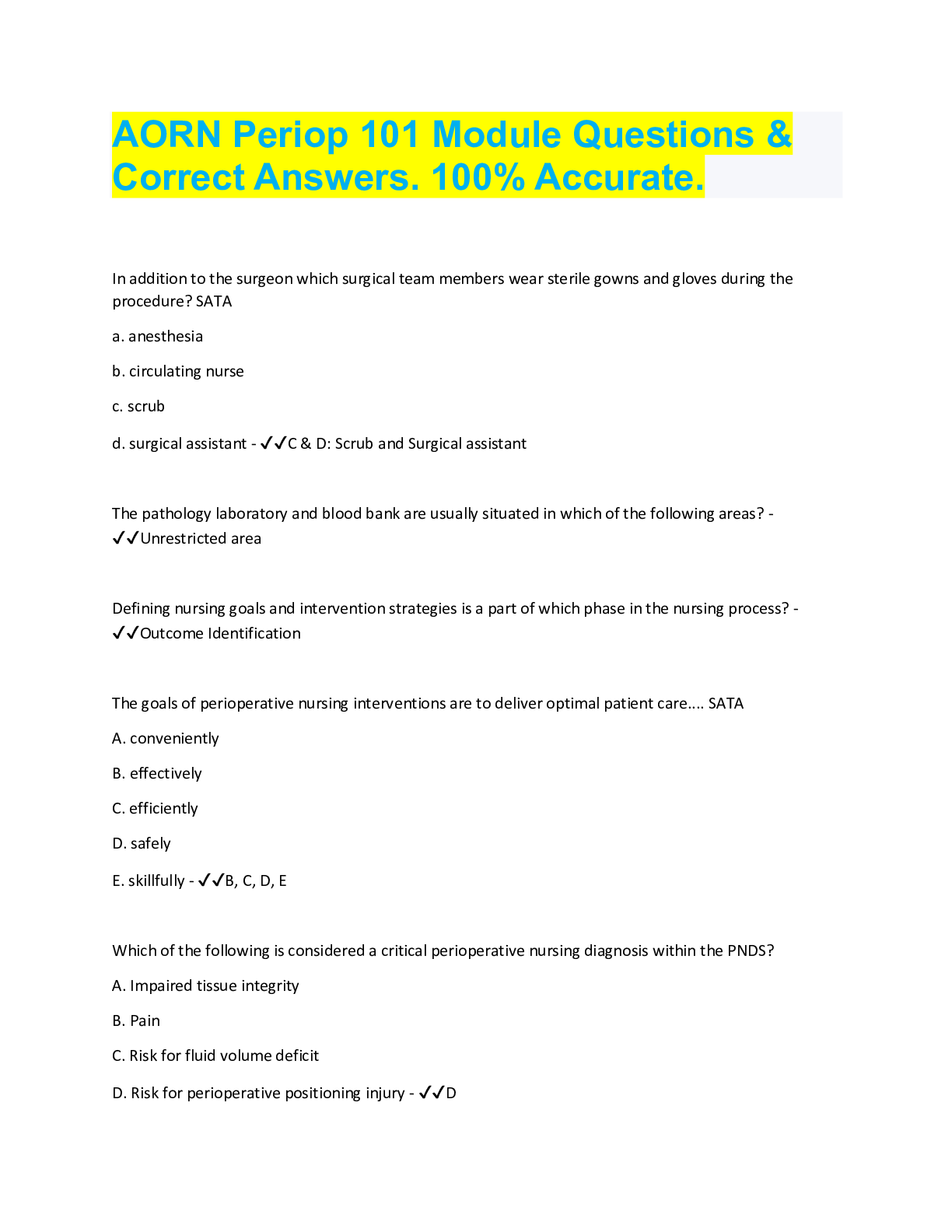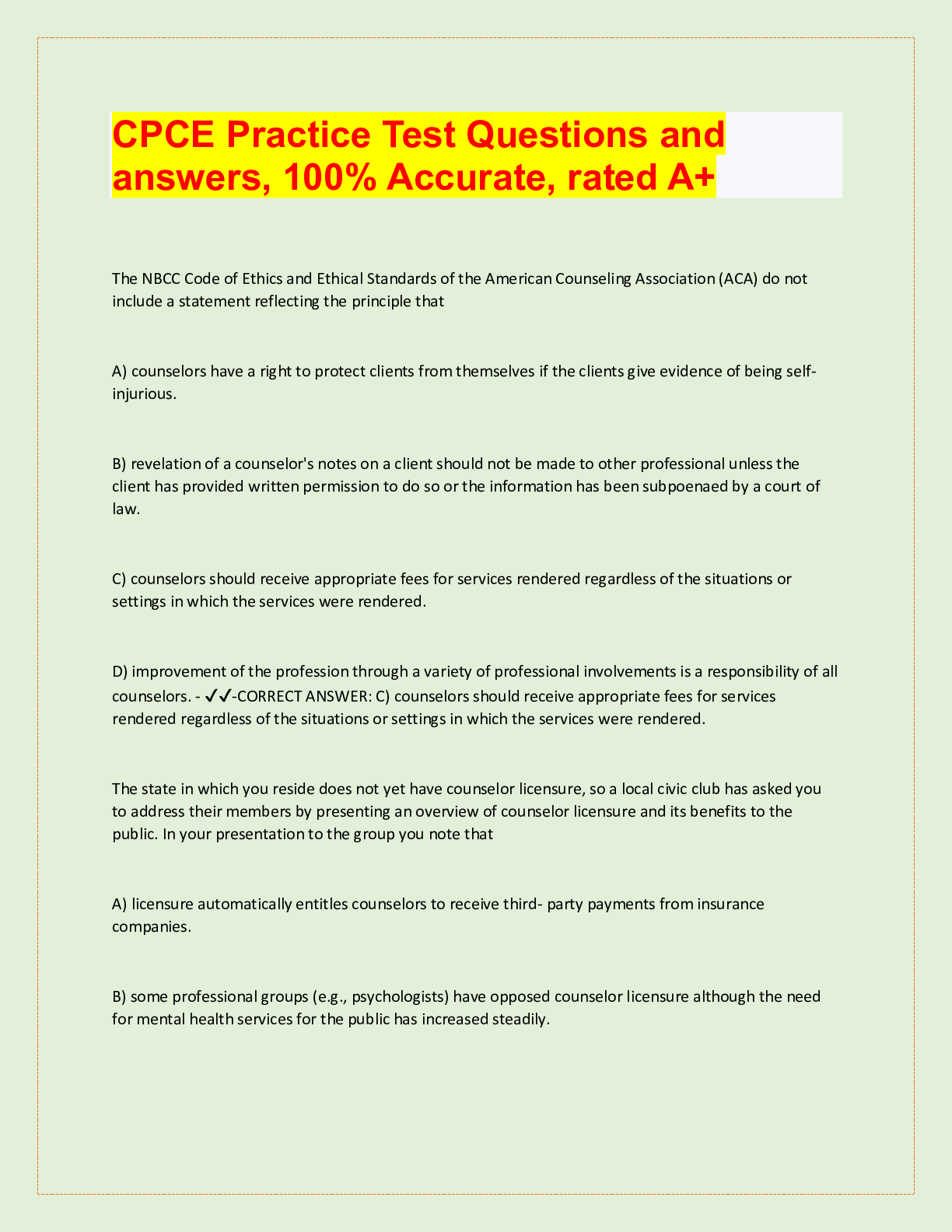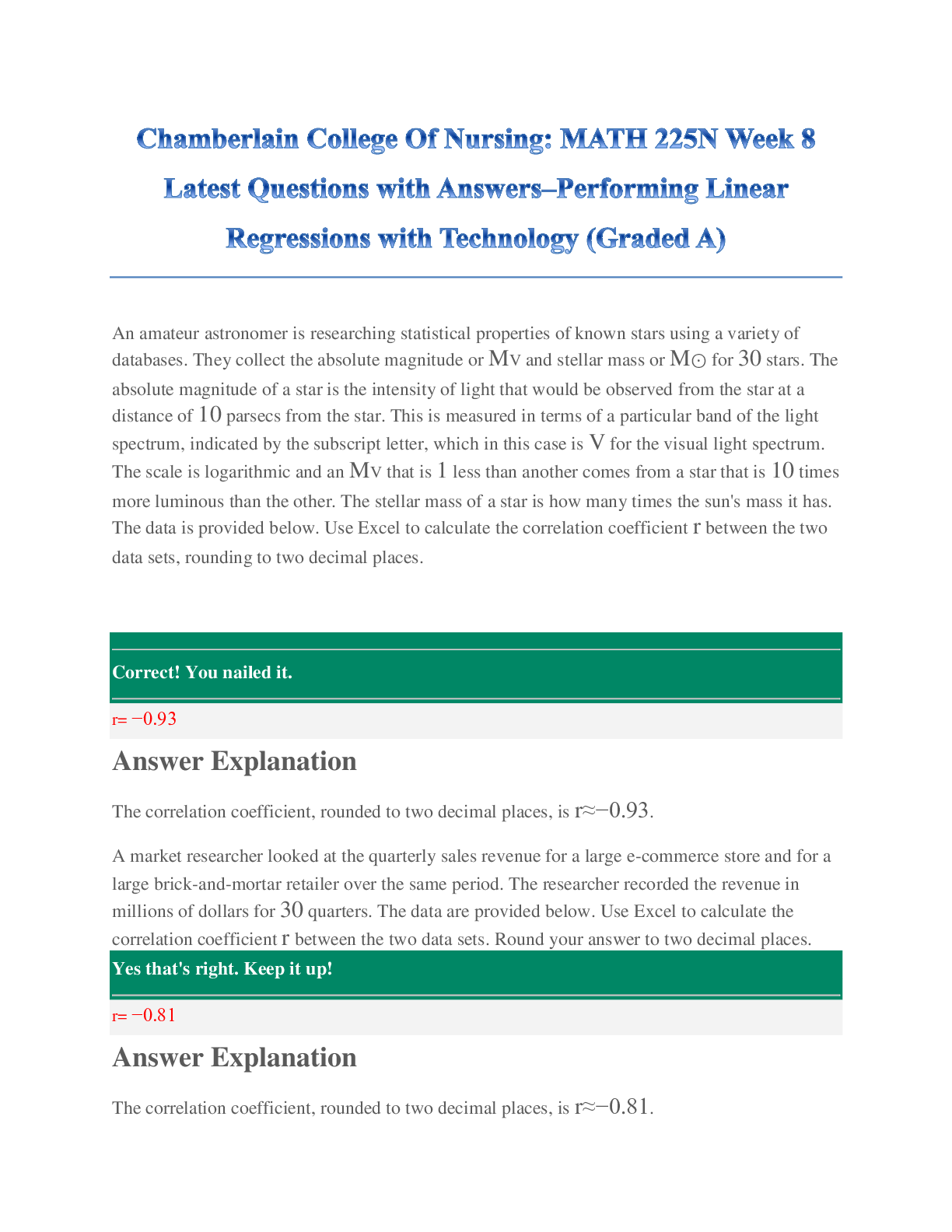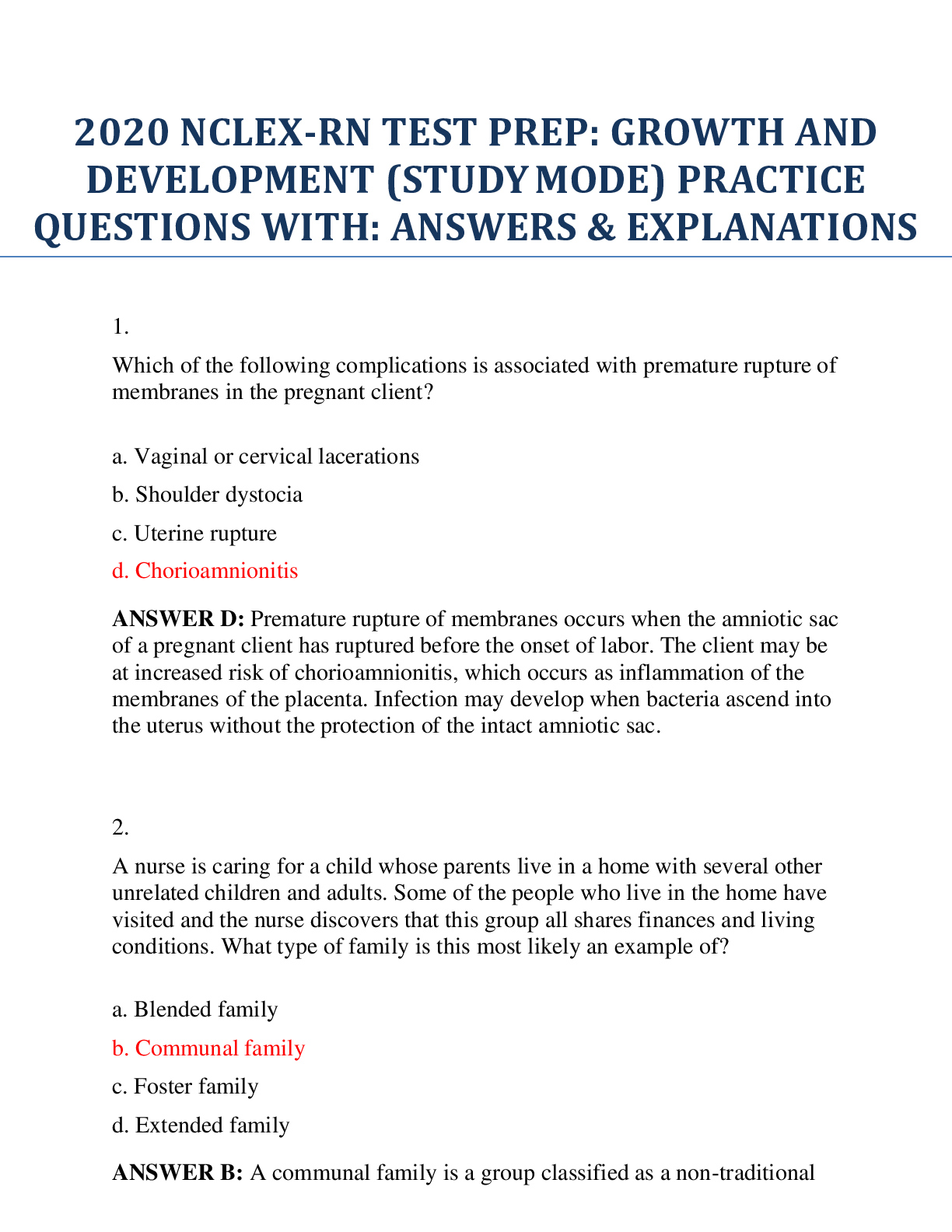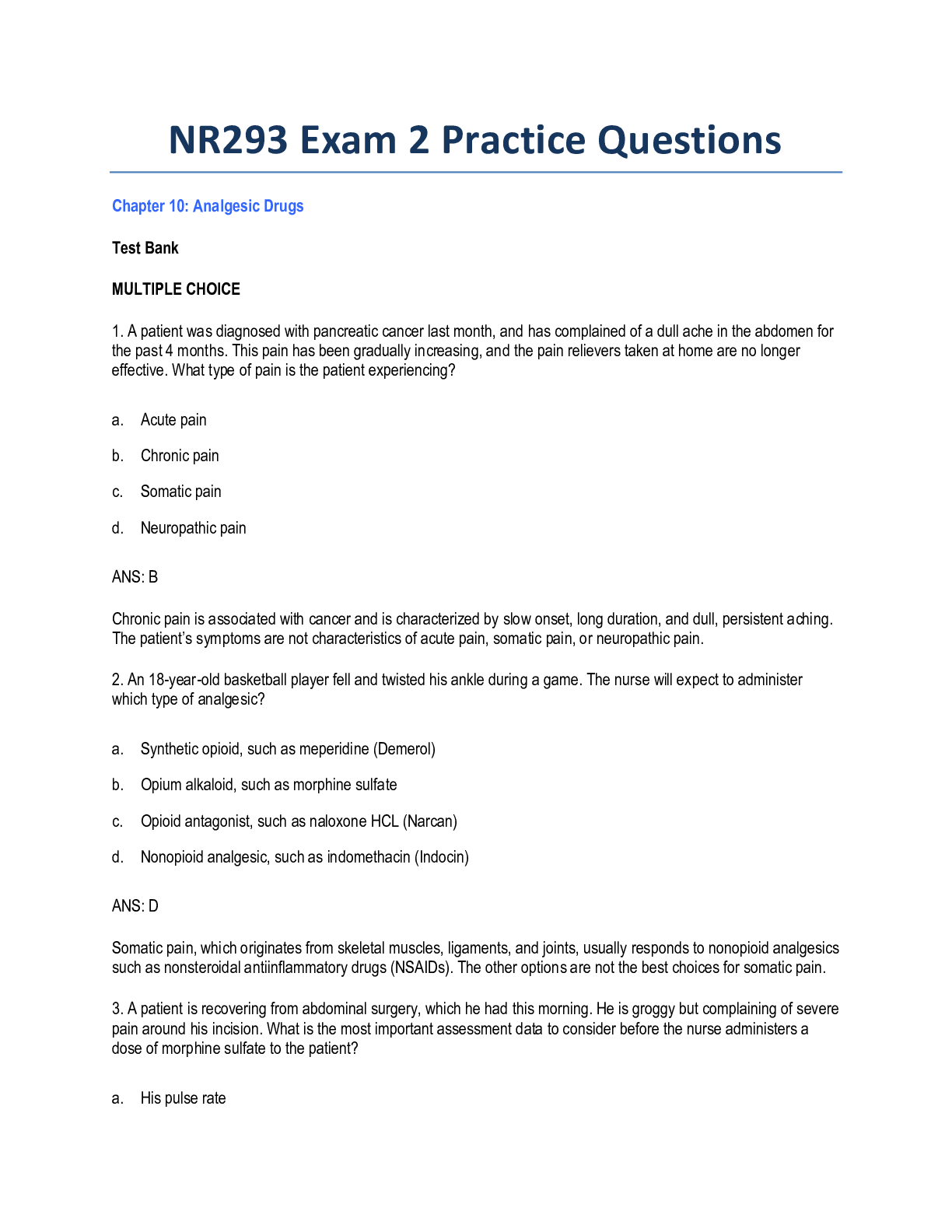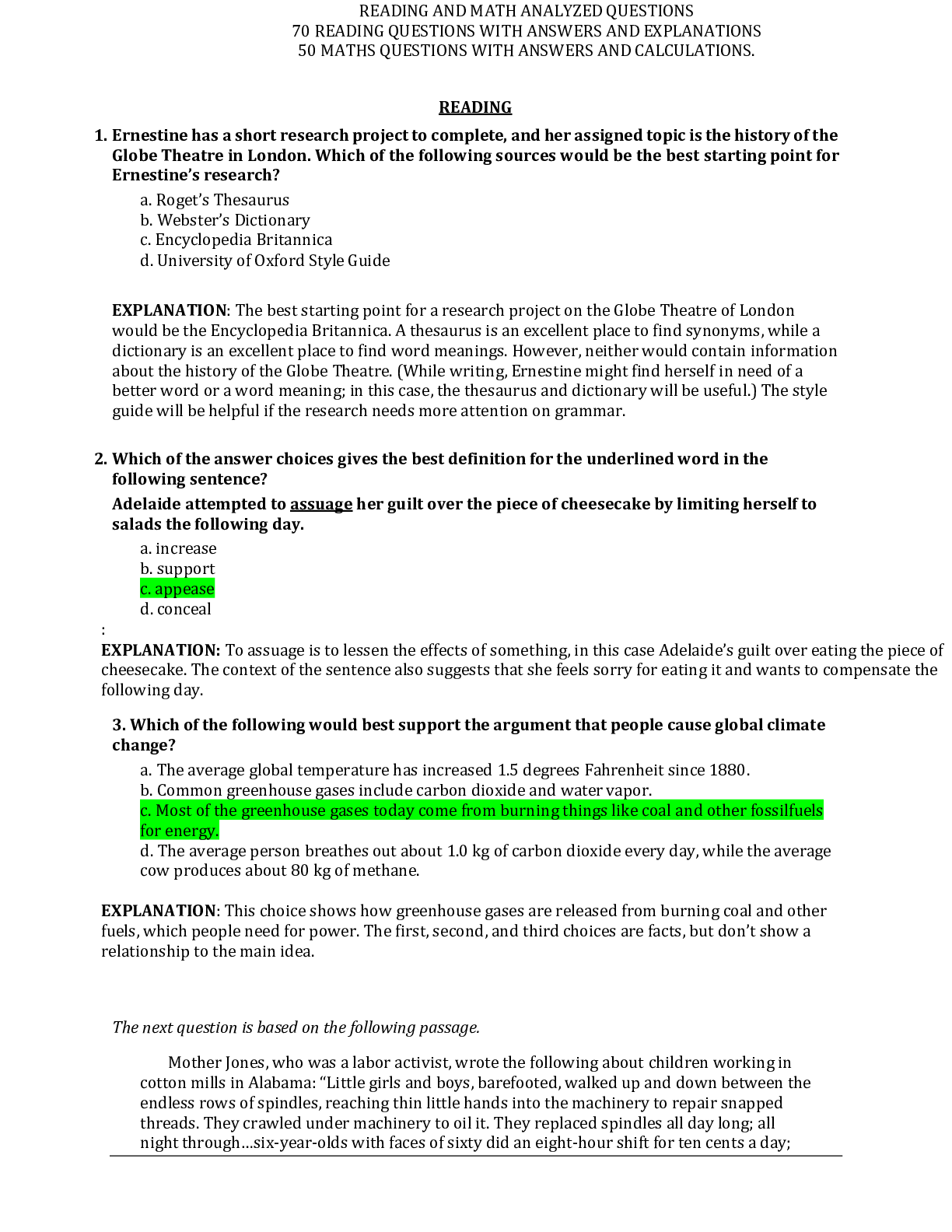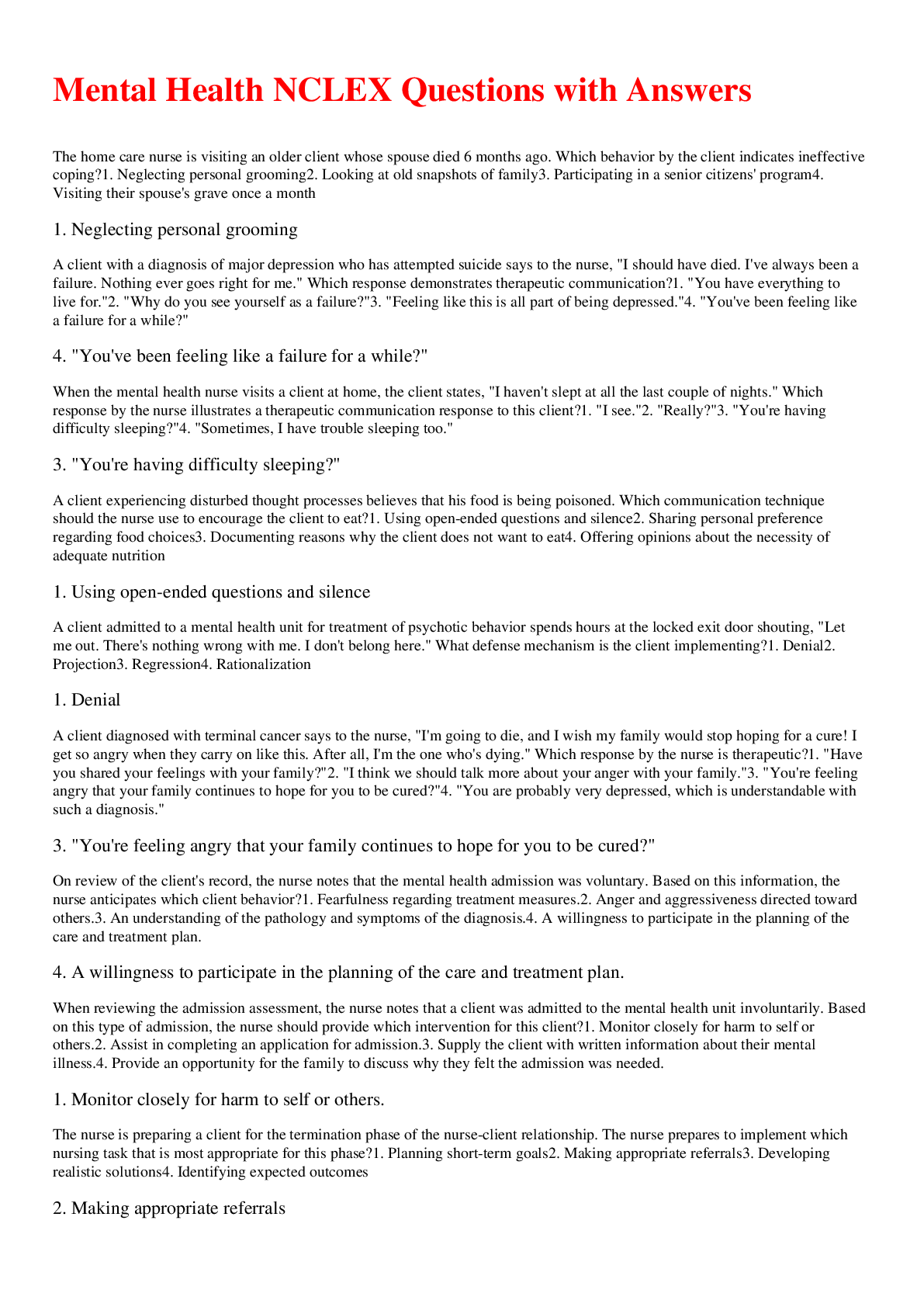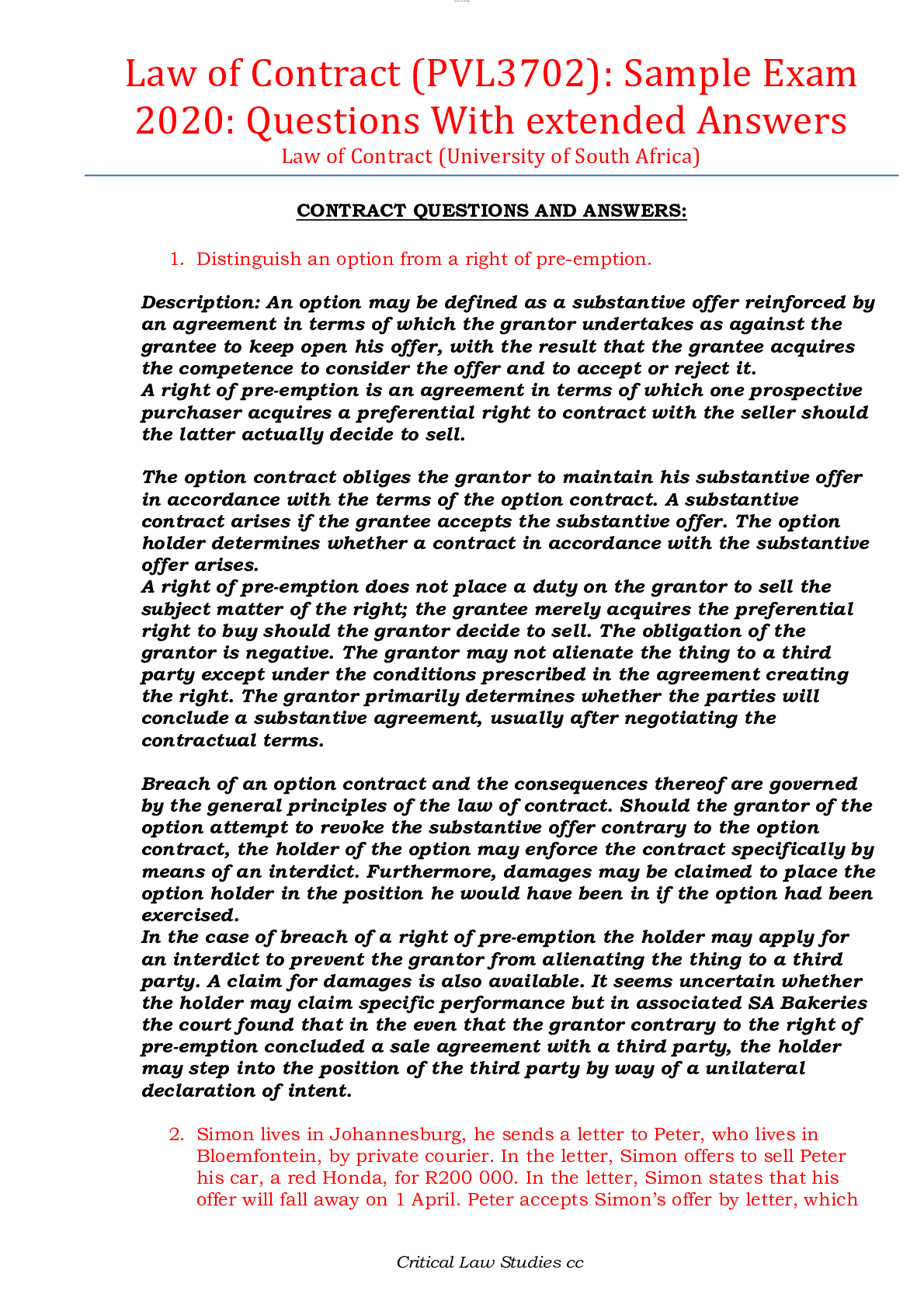*NURSING > QUESTIONS & ANSWERS > ACE Personal Training Manual 5th Edition. Questions Bank. Top Exam Questions with accurate Answers (All)
ACE Personal Training Manual 5th Edition. Questions Bank. Top Exam Questions with accurate Answers. Rated A+ Health benefits
Document Content and Description Below
ACE Personal Training Manual 5th Edition. Questions Bank. Top Exam Questions with accurate Answers. Rated A+ Health benefits occur with at least ___ minutes per week? - ✔✔150 Health Benefi... ts Associated with regular physical activity in Adults and Older Adults? - ✔✔- lower risk of early death - lower risk of CAD (coronary artery disease) - lower risk of stroke - lower risk of high blood pressure - lower risk of adverse blood lipid profile - lower risk of type 2 diabetes - lower risk of metabolic diseases (syndrome) - lower risk of colon cancer - lower risk of breast cancer - prevention of weight gain - weight loss, when combined with proper diet - improved cardiorespiratory and muscular fitness - prevention of falls - reduced symptoms of depression - better cognitive function - increased bone density (type of training) - improve sleep quality Allied Healthcare Continuum - ✔✔Composed of health professionals who are credentialed through certifications and or licences. Physicians/Doctors are the top of the pyramid - Acupuncturist - Chircopractor - Dietians - Naturopathic physicians - Nurses - physicans - Behavioral medicine practitioners - physical therapists - occupational therapists - athletic trainers ACE CPT can work with who? - ✔✔- Apparent healthy individuals - clients with special needs (with doctors clearance for exercise) - and small groups with minimal supervision Personal trainers job - ✔✔make safe effective exercise-programming decisions in a variety of practical situations, while minimizing client risk and exposure to harm (e.g. physical, emotional, psychological, financial or other harm) Scope of practice - ✔✔legal range of services that professional can provide, the setting in which those services can be provided and the guidelines or parameters that must be followed study time for test - ✔✔3-4 months certification purpose? - ✔✔protect public from harm ACE code of ethics? - ✔✔governs ethical and professional conduct Certification Valid for? - ✔✔2 years To Keep Certification? - ✔✔- 20 hours of C.EC - CPR certification (cardiopulmonary resuscitation) - AED certification (Automated external Defibrillator) grace period after expiration? - ✔✔6 months what percent of adults meet both aerobic and muscle strengthening guidelines? - ✔✔20% job of a personal trainer (adherence)? - ✔✔increasing the likelihood that people will adhere to a program once they have started Adults should engage in how many minutes per week of physical activity ? - ✔✔75 minutes of vigorous or 150 minutes of moderate Muscle strengthening activities per week? - ✔✔moderate to high intensity and involve every major muscle group 2 or more days per week 50% of people who start a program? - ✔✔will drop it within 6 months Assertivness - ✔✔honest straightforward expression of one's thoughts and feelings and beliefs self regulators? - ✔✔effective at self regulation - time - priorities - schedules - behaviours Factors affecting adherence? - ✔✔- personal attributes - environmental attributes - physical-activity attributes Personal attributes? - ✔✔- demographic variables (gender/age) - health status (illness/disease) - activity history - physiological traits (self-efficacy) - knowledge attitudes and beliefs (locus of control = belief that they have control over their health outcomes) (perceived barriers = lack of time) Environmental factors - ✔✔- access to facilities (no gyms close by) - time - social support (family and friends) physical activity factors - ✔✔- intensity (vigorous intensity workouts high dropout rate) - injury (sore back) Leadership - ✔✔- professionalism - trust - listen to client - excitement in their craft - innovate and educated - interested in their progress Role clairty - ✔✔- expectations no clearly defined - clarify your role clearly - responsibilities and roles Goal setting? - ✔✔- avoid too many goals - avoid negative goals - set short and long term - process and performance goals - revisit goals regularly Stages of client trainer relationship? - ✔✔1. rapport 2. investigation 3. planning 4. action rapport? - ✔✔- first time meeting - relationship and trust - first impressions (important) investigation? - ✔✔- review clients health and fitness data - any available tests - medical clearance info - clients goals and exercise history - good listening skills Planning? - ✔✔- designs exercise plan in partnership with client - generating discussions and alternatives - formulating a plan - evaluate the exercise program - ready to begin working out Action? - ✔✔- ability to teach new motor skills - setting up self-motivating systems - Individualizing teaching techniques Verbal and nonverbal communication? - ✔✔- voice quality - eye contact - facial expression - hand gestures - body position Listening skills - ✔✔- encouraging (I know what you mean) - paraphrasing (demonstrate understanding) - questioning (open ended questions) - reflecting (understanding or seek clarification) - summarizing (confirm accuracy) response to difficult disclosures? - ✔✔short concise "im so sorry" Process goals? - ✔✔something a client does - completing a certain number of workouts per week product goals? - ✔✔is something achieved - weight loss achieved - or resistance (weight) achieved Motivational interviewing? - ✔✔a method of speaking with people in a way that motivates them make a decision or change a behaviour - ask probing questions - listen effectively - provide educational info - keep convo friendly - build self confidence - encourage clients to generate ideas learning styles - ✔✔1. visual 2. auditory 3. kinesthetic (tactile) tell show do method? - ✔✔tell them, show them, have them do it - motor learning - remind them takes time to improve motor skills - introduce new skills slowly - allow for focused practice Feedback - ✔✔- start with what was done well - then correct errors - motivate clients to continue practicing and improving Cultural competence? - ✔✔working with people of various backgrounds Stages of learning? - ✔✔1. Cognitive (new motor skills are being learned, movements usually uncoordinated and clumsy) 2. Associative (client begins to master basics, and are ready for more specific feedback 3. Autonomous (clients are performing motor skills effectively and naturally) Health Belief Model? - ✔✔Most accepted theory - predicts that people will engage in a health behaviour based on the perceived threat that they feel regarding a health problem and the pros and cons of adopting that behaviour - perceived seriousness - perceived susceptibility (likelihood of developing it) - cues to action (symptoms) 6 sources of self-efficacy? - ✔✔1. past performance (most important) 2. vicarious experiences (seen someone similar have success) 3. Verbal persuasion (feedback) 4. physiological state appraisals (pain, fatigue) 5. emotional state (mood) 6. imaginal experiences (positive/negative views of exercise) High self-efficacy? - ✔✔- more likely to adhere to a program than lower self-efficacy - high will also choose harder tasks than low Transtheoretical model of behavioural change? (stages of change model) - ✔✔A individuals readiness for change 1. stages of change 2. process of change 3. self-efficacy 4. decisional balance Stages of change? - ✔✔1. precontemplation (sedentary and not even considering activity) 2. contemplation (Sedentary but starting to consider activity) 3. preparation (marked by some physical activity, may be a sporadic walk or even a visit to the gym but it is inconsistent) 4. action (people engage in regular activity but have been doing so for less the 6 months) 5. maintenance (regular activity for more than 6 months) Process of change? - ✔✔1. make inactivity a relevant issue and start thinking about being active 2. to get involved in some type of activity 3. regular activity particapation 4. maintain activity 5. prevent relapse and maintain Self Efficacy? - ✔✔try and give quick successes to increase their belief they can successfully adopt this behaviour Decisional Balance? - ✔✔- pros and cons of adopting Relapse? - ✔✔set back into old behaviour/habits - due to various variables (work, school ,family health) biggest mistake for behavioural change? - ✔✔that PT think it is easy Operant Conditioning? - ✔✔process by which behaviours are influenced by their *consequences* - behaviour chains that lead to the engagement of certain behaviours and the avoidance of others, taking into account the consequences Antecedents? - ✔✔variables or factors that precede and influence a clients exercise participation, including the decision to not exercise as planned Stimulus control? - ✔✔controlling the environment - making changes to the environment - a means to break the connection between events or other stimuli and a behaviour (cue extinction) Consqeuences - ✔✔Negative or positive reinforcement - positive = increase likelihood that behaviour will occur in the future Shaping - ✔✔refers to the process of using reinforcements to gradually achieve a target behaviour cognitions? - ✔✔thoughts willpower - ✔✔the ability to delay gratification (short term discomfort to pursue long term goal) Effective behaviour change techniques? - ✔✔- goal setting - feedback - decision making - self monitoring Decision making? - ✔✔clients ability to control a situation and choose appropriately among alternative courses of action ADL - ✔✔Activities of daily living - what PT try to enhance through programs (easier and more fun) Contemporary Training parameters? - ✔✔- health behaviour change - postural (kinetic chain) stability - kinetic chain mobility - movement efficiency - core conditioning - balance - cardiorespiratory fitness (aerobic + anaerobic) - metabolic markers (ventilatory thresholds) - muscular endurance - muscuale strength - flexibility - agility, coordination, and reactivity - speed and power Chronic - ✔✔Continuing for a long time Acute - ✔✔occurs suddenly exercise prevents? - ✔✔- type 2 diabetes - CAD (coronary arteries disease) - hypertension (high blood pressure) - health risks associated with obesity Aerobic (cardiovascular endurance) general recommendations - ✔✔*Frequency:* - greater or equal to 5 days/week (moderate) - greater equal to 3 days/week (vigorous) - 3-5 days/week for combination (M + V) *Intensity:* - moderate-vigorous (most adults) - light-moderate (deconditioned adults) *Time:* - 30-60 minutes/day moderate - 20-60 minutes/day vigorous - < 20 minutes can be beneficial (especially sedentary) *Type:* - regular purposeful exercise involves major muscle groups and is continuous and rhythmic *Other:* - 500-100 MET week - > 2000 steps/day - . 7000 steps/day = best - exercise of <10 mins good for sedentary Resistance Exercise (general recommendations) - ✔✔*Frequency:* -each major muscle group 2-3 days/week *Intensity:* - 60-70% 1RM (moderate-vigorous) = novice/intermediate to improve strength - >80% 1RM (vigorous-very vigorous) = experienced trainers - 40-50% 1RM (very light- light) older adults beginning and sedentary - >50% 1RM improve musucalar endurance - 20-50% = older adults *Time:* - n/a *Type:* - each major muscle group - multijoint exercise - single joint exercises - equipment and body weight *Reps:* - 8-12 strength and power - 10-15 older adults starting (power) - 15-20 muscular endurance *Sets:* - 2-4 sets strength and power - less than or equal to 2 sets for endurance *Other:* - 2-3 mins of rest between sets - 48 hours of rest for any single muscle group sedentary client focused on improved function, how long? - ✔✔4-6 weeks of conditioning program, before focusing on program variables (FITT) Successful personal trainers do what? - ✔✔- excellent communication - teaching techniques - psychological needs of client - emotional needs of client - physiological needs of client - Concerns of client Sample assessment sequencing - ✔✔Session 1st: health risk appraisal (heart rate, blood pressure, height and weight) 1st/2nd: medical clearance and static posture 1st/2nd: flexibility (movements screens) Week 1: balance (static and dynamic) core function week 2: health related assessments (flexibility, body composition, aerobic power) week 3: muscular endurance and strength (skills = agility, coordination, reaction time, speed, and power) exercise program progressions? 4 different steps - ✔✔1. Function 2. Health 3. Fitness 4. Performance ACE Integrated fitness model has 2 principal training components? - ✔✔1. functional movement and resistance training 2. cardiorespiratory training Each of which has 4 phases Functional movement and resistance training - ✔✔phase 1: mobility and stability training phase 2: movement training phase 3: load training phase 4: performance training Cardiorespiratory Training - ✔✔phase 1: Aerobic base phase 2: aerobic efficiency phase 3: anaerobic endurance phase 4: anaerobic power Phase 1 - ✔✔- improve joint stability and mobility - aerobic base to improve parameters phase 2 - ✔✔- aerobic intervals to improve efficiency - training movement patterns phase 3 - ✔✔- load training - anaerobic endurance phase 4 - ✔✔- training for power, speed, agility reactivity - anaerobic power greatest impact PT can have on clients life? - ✔✔- help them change help related habits - establish positive relationship with exercise after how many weeks will mood improve (client) regular physical activity? - ✔✔2-4 weeks will generally experience more stable positive moods due to: - changes in hormone neurotransmitter levels (endorphins, serotonin, and norepinephrine) - increased self-efficacy - improved performance from neuromuscular adaptations Core of human movement? - ✔✔posture: - weak core muscles - muscles imbalances - postural deviations are at higher risk of injury when external loads or movements are applied how to move from phase 2 to phase 3 (resistance training) - ✔✔demonstrate: - body-weight sequences with proper form - core stabilization - control of COG (center of gravity) - control of velocity of movement phases are based on what? - ✔✔- specificity - overload - progression all movement begins and ends from? - ✔✔position of posture - goal of first phase is to help clients improve posture Phase 1: Stability and mobility assessments? - ✔✔- Posture - Balance - Movement - Range of motion of ankle, hip, shoulder, thoracic, and lumbar spine Phase 1: Stability and mobility - ✔✔- low intensity exercise to improve: muscle balance, muscular endurance, core function, flexibility and static and dynamic posture all with the goal of *postural stability* throughout the kinetic chain without compromising mobility at any point in the chain phase 1 intensity (Stability and mobility) - ✔✔low and usually body weight movements only Phase 2 goal (resistance training)? - ✔✔- training movement patterns (develop mobility within the kinetic chain without compromising stability) 5 primary movements for Phase 2? (resistance training) - ✔✔1. bend and lift movements (squatting) 2. single leg movements (lunging) 3. pushing movements (push-up) 4. pulling movements (pull-up) 5. rotational movements (t-spine rotation) Unilateral movement screens? - ✔✔single leg movements - pushing, pulling or bend and lift can be performed in either bilaterally or unilaterally Any resistance training in phase 2 should be? (resistance training) - ✔✔muscular endurance and promote mobility, with an emphasis on controlled motion and deceleration performed via controlled eccentric muscle actions. Phase 3: load training - ✔✔external force is applied to facilitate muscular force production Goal: improve motor unit recruitment Undulating periodization? - ✔✔a form of periodization used in resistance training that provides different training protocols during microcycles in addition to changing the training variables after each microcycle Power equations? - ✔✔power = force x velocity or power = Work/Time Force = - ✔✔Mass x Acceleration Velocity = - ✔✔Distance/Time Work = - ✔✔Force x Distance Plyometric training is? - ✔✔jump training Goal of phase 4 performance training is? (power training) - ✔✔Power training is used to increase *rate coding* (speed at which motor units stimulate the muscle to contract and produce force) Power training? - ✔✔maximizing the stretch reflex by minimizing the *transition time* between eccentric and concentric phase of muscle action - The faster a muscle can transition from lengthening to shortening the greater amount of force is generated by the muscle during the concentric phase (shortening) Power originates from where? - ✔✔body's point of contact with a stable surface (ground) phase 4 muscle fiber? - ✔✔type 2 muscle fibers: - responsible for high force - short duration contractions Lactate threshold (LT)? - ✔✔The point during exercise of increasing intensity at which blood lactate begins to accumulate above resting levels, where lactate clearance is no longer able to keep up with lactate production Lactate? - ✔✔chemical derivative of lactic acid, which is formed when sugars are broken down for energy without the presence of oxygen Lactic Acid? - ✔✔a metabolic byproduct of anaerobic glycolysis , when it accumulates it decreases blood pH which slows down enzyme activity and ultimately causes fatigue Phase 1 aerobic base? - ✔✔developing initial aerobic base for clients who have been sedentary or near sedentary measuring intensity in phase 1? - ✔✔talk test is best - likely below VT1 (ventilatory threshold 1) - moderate intensity - RPE = 3-4 phase 1 time (aerobic) - ✔✔5-20 mins phase 1 goal? (times per week and mins) - ✔✔- 3-4 days a week - 20-30 min duration - RPE 3-4 Phase 2 (aerobic efficiency) - ✔✔progress through increased duration of sessions, increased frequency of sessions and the introduction of aerobic intervals Aerobic intervals (phase 2) - ✔✔introduced just above VT1 or and RPE scale of 5 (strong) goal: improve aerobic endurance by raising the intensity performed at VT1 and to improve clients ability to utilize fats Phase 3 focus (anaerobic-endurance training) - ✔✔- program that helps improve performance in endurance events or to train fitness enthusiasts for higher levels of cardiorespiratory fitness - increase amount of time one can sustain work at or near VT2 - increase ability of working muscles to produce force for an extended period of time Phase 3 How? (anaerobic) - ✔✔higher intensity intervals that load the cardiovascular system - sometimes called lactate threshold or tolerance training First Ventilatory threshold? (VT1) - ✔✔Intensity of aerobic exercise at which ventilation starts to increase in a nonlinear fashion in response to accumulation of metabolic by-products in the blood Second Ventilatory threshold? (VT2) - ✔✔A metabolic marker that represents the point above which high intensity exercise can only be sustained for a brief interval due to an accumulation of lactate PHASE 3: Time spent in certain zones (1, 2, 3) (VT1 + VT2) - ✔✔Zone 1 = at or below VT1 (RPE 3-4) Zone 2 = between VT1 & VT2 (RPE 5-6) Zone 3 = At or above VT2 (RPE ≥ 7) Time Spent: Zone 1 = 70-80% Zone 2 = 10% Zone 3 = 10-20% Anaerobic Power training? - ✔✔-many clients will never reach this phase - intervals are designed to develop peak power and aerobic power with intervals well above VT2 or an RPE of ≥ 9 (Very, very strong) - overload fast glycolytic and challenge the phosphagen system - enhancing clients ability to perform high-intensity training for extended periods of time - 3-7 days per week - 20 mins-several hours Fast glycolytic (Lactate System) - ✔✔Anaerobic process of metabolism that breaks down glucose and glycogen into ATP during high-intensity physical activity Phosphagen System? - ✔✔High-energy phosphate compounds found in muscle tissue, including ATP (adenosine triphosphate) and CP (creatine phosphate) Can be broken down right away for immediate use by the cells PHASE 4: Time spent in certain zones (1, 2, 3) (VT1 + VT2) - ✔✔Zone 1 = at or below VT1 (RPE 3-4) Zone 2 = between VT1 & VT2 (RPE 5-6) Zone 3 = *well above VT2 (REP 9-10) maximum output* Same Time Spent as phase 3: Zone 1 = 70-80% Zone 2 = 10% Zone 3 = 10-20% Rapport means - ✔✔mutual trust, harmony and affinity these 3 attributes are essential to a successful relationships - ✔✔1. empathy = ability to experience another person's world as if were one's own 2. warmth = positive regard or respect for another person regardless of individuality or uniqueness, safety and acceptance 3. genuineness = authenticity or ability to be honest and open with the client Distance from client when talking? - ✔✔1.5-4 feet Humans can speak? - ✔✔150-250 words per minute but, can listen to 500 words per minute Indifferent listening - ✔✔person is not really listening or is tuned out selective listening - ✔✔listens to only key words passive listening - ✔✔impression of listening by giving non-committal agreements (head nods) active listening - ✔✔shows empathy and listens as if he or she is in the speakers shoe Avoid questions that? (interviewing) - ✔✔answer with yes or no Minimal encouraging (interviewing) - ✔✔please explain what you mean by occasional knee pain Paraphrasing (interviewing) - ✔✔restating the essence of the content probing (interviewing) - ✔✔please tell me more about the medications you are taking reflecting (interviewing) - ✔✔restating what the speaker said (essence) but chaining the words clarifying (interviewing) - ✔✔verify the understanding of content of clients communication informing (interviewing) - ✔✔expanding upon previously shared info, if they said they have asthma, tell them pros and cons of exercise etc.. Confronting (interviewing) - ✔✔mild strong feedback with a client, can encourage accountability when clients display lethargy or lack of motivation Questioning (interviewing) - ✔✔directing both open-end and closed ended questions to a client Deflecting (interviewing) - ✔✔changing the focus of one individual to another Motivational interviewing - ✔✔client-centered directive method for enhancing intrinsic motivation by exploring and resolving ambivalence ambivalence - ✔✔the state of having mixed feelings or contradictory ideas about something or someone in other words it is used to get clients off the fence about exercise Positive impact of physical activity & exercise? - ✔✔- reduce risk of cardiovascular, metabolic and pulmonary disease - reduce certain types of cancer - reduce anxiety - reduce depression - reduce chance of premature death Pre-participation screening? - ✔✔- identify presence or absence of CAD, PAD + MD - identify clients with contraindications (health conditions or risk factors) - detecting at risk clients who should undergo medical evaluation first - identifying clients with medical conditions who should participate in medically supervised programs contraindications - ✔✔Any condition that renders some particular movement, activity or treatment improper or undesirable PAR-Q (Physical Activity Readiness Questionnaire) - ✔✔- serves as a minimal health risk appraisal prerequisite - quick and easy and non invasive - limited in it lack of detail atherolcletoric Cardiovascular disease for risk factor thresholds (point system) (risk stratification) - ✔✔Age: - Men ≥ 45 years olds = +1 point - Women ≥ 55 years old = +1 point Family History: - Myocardial infarction, sudden death, or coronary revascularization before age 55 in father (or other first degree male relative) and 65 age for women = 1+ point Cigarette Smoking: - current or quit within previous 6 months, or second hand smoke = 1+ point Sedentary lifestyle: - less than 30 mins moderate intensity physical activity on at least 3 days per week/for at least 3 months = 1+ point Obesity: - Body mass ≥ 30 - waist girth measurement men = ≥ 40 inches - waist girth measurement women = ≥ 35 inches = 1+ p [Show More]
Last updated: 1 year ago
Preview 1 out of 109 pages

Buy this document to get the full access instantly
Instant Download Access after purchase
Add to cartInstant download
We Accept:

Also available in bundle (1)

ACE FINAL Exam BUNDLE, Approved Exam predictor.
ACE FINAL Exam. Top Questions with accurate answers. 100% Verified Predictor paper. 24 exam versions.
By Topmark 1 year ago
$38
23
Reviews( 0 )
$13.00
Document information
Connected school, study & course
About the document
Uploaded On
Mar 14, 2023
Number of pages
109
Written in
Additional information
This document has been written for:
Uploaded
Mar 14, 2023
Downloads
0
Views
79






